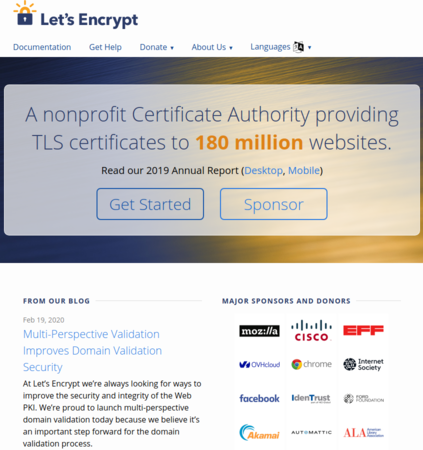Difference between revisions of "Obtaining a Digital Certificate from Lets Encrypt"
| Line 1: | Line 1: | ||
[[File:lets_encrypt.png|right|thumb|x450px|alt=The Let's Encrypt Website|The Let's Encrypt Website]] | [[File:lets_encrypt.png|right|thumb|x450px|alt=The Let's Encrypt Website|The Let's Encrypt Website]] | ||
Much of this information is sourced from: https://letsencrypt.org/getting-started/ | Much of this information is sourced from: https://letsencrypt.org/getting-started/ | ||
| + | |||
| + | == Pre-requisites == | ||
Before starting to ensure that you have an A record pointing to the IP address of your server. To verify that you have met this prerequisite, you should be able to ssh from your local machine. For example, the following should be successful | Before starting to ensure that you have an A record pointing to the IP address of your server. To verify that you have met this prerequisite, you should be able to ssh from your local machine. For example, the following should be successful | ||
| Line 11: | Line 13: | ||
If these tests fail, go back to the Amazon EC2 server lab and the DNS lab and make sure these tests work before you proceed. | If these tests fail, go back to the Amazon EC2 server lab and the DNS lab and make sure these tests work before you proceed. | ||
| + | |||
| + | == Obtaining your digital certificate from Let's Encrypt == | ||
You should, for testing purposes have TCP port 22, 80 and 443 available through the firewall. Once you have tested that your website is working over HTTP (port 80), it is time to get a certificate and enable it over HTTPS (port 443). Go to: | You should, for testing purposes have TCP port 22, 80 and 443 available through the firewall. Once you have tested that your website is working over HTTP (port 80), it is time to get a certificate and enable it over HTTPS (port 443). Go to: | ||
Revision as of 04:28, 24 April 2020
Much of this information is sourced from: https://letsencrypt.org/getting-started/
Pre-requisites
Before starting to ensure that you have an A record pointing to the IP address of your server. To verify that you have met this prerequisite, you should be able to ssh from your local machine. For example, the following should be successful
ssh ubuntu@[yourdomain-name-goes-here.com]
I will also assume that you are running the Apache web server and have current access. You could use a web browser or from the CLI you could:
wget http://[yourdomain-name-goes-here.com]
If these tests fail, go back to the Amazon EC2 server lab and the DNS lab and make sure these tests work before you proceed.
Obtaining your digital certificate from Let's Encrypt
You should, for testing purposes have TCP port 22, 80 and 443 available through the firewall. Once you have tested that your website is working over HTTP (port 80), it is time to get a certificate and enable it over HTTPS (port 443). Go to:
https://certbot.eff.org/
Select I'm using "Apache" on "Ubuntu 18.04". This will provide you with the instructions, which I have re-provided below. These instructions add additional repositories that will allow your Ubuntu instance to download the correct packages.
sudo apt-get update sudo apt-get install software-properties-common sudo add-apt-repository universe sudo add-apt-repository ppa:certbot/certbot sudo apt-get update
Then install certbot
sudo apt-get install certbot python-certbot-apache
Then, get the apache plugin
sudo certbot --apache
Follow the prompts and after you finish, you can test.
If you are happy with this, consider turning on auto renewal
sudo certbot renew --dry-run
